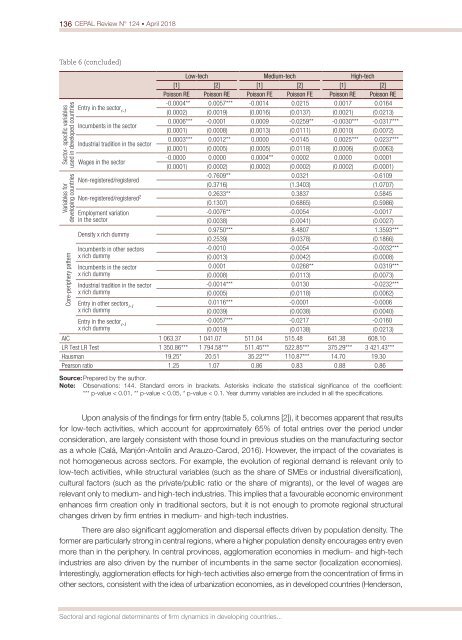CEPAL Review no. 124
April 2018
April 2018
You also want an ePaper? Increase the reach of your titles
YUMPU automatically turns print PDFs into web optimized ePapers that Google loves.
136 <strong>CEPAL</strong> <strong>Review</strong> N° <strong>124</strong> • April 2018<br />
Table 6 (concluded)<br />
Sector- specific variables<br />
used in developed countries<br />
Variables for<br />
developing countries<br />
Core-periphery pattern<br />
Low-tech Medium-tech High-tech<br />
[1] [2] [1] [2] [1] [2]<br />
Poisson RE Poisson RE Poisson FE Poisson FE Poisson RE Poisson RE<br />
-0.0004** 0.0057*** -0.0014 0.0215 0.0017 0.0164<br />
Entry in the sector t-1<br />
(0.0002) (0.0019) (0.0016) (0.0137) (0.0021) (0.0213)<br />
Incumbents in the sector<br />
0.0006*** -0.0001 0.0009 -0.0259** -0.0030*** -0.0317***<br />
(0.0001) (0.0008) (0.0013) (0.0111) (0.0010) (0.0072)<br />
Industrial tradition in the sector<br />
0.0003*** 0.0012** 0.0000 -0.0145 0.0025*** 0.0237***<br />
(0.0001) (0.0005) (0.0005) (0.0118) (0.0006) (0.0063)<br />
Wages in the sector<br />
-0.0000 0.0000 0.0004** 0.0002 0.0000 0.0001<br />
(0.0001) (0.0002) (0.0002) (0.0002) (0.0002) (0.0001)<br />
Non-registered/registered<br />
-0.7609** 0.0321 -0.6109<br />
(0.3716) (1.3403) (1.0707)<br />
Non-registered/registered 2 0.2633** 0.3837 0.5845<br />
(0.1307) (0.6865) (0.5986)<br />
Employment variation<br />
-0.0076** -0.0054 -0.0017<br />
in the sector<br />
(0.0038) (0.0041) (0.0027)<br />
Density x rich dummy<br />
0.9750*** 8.4807 1.3593***<br />
(0.2539) (9.0378) (0.1866)<br />
Incumbents in other sectors<br />
-0.0010 -0.0054 -0.0032***<br />
x rich dummy<br />
(0.0013) (0.0042) (0.0008)<br />
Incumbents in the sector<br />
0.0001 0.0268** 0.0319***<br />
x rich dummy<br />
(0.0008) (0.0113) (0.0073)<br />
Industrial tradition in the sector<br />
-0.0014*** 0.0130 -0.0232***<br />
x rich dummy<br />
(0.0005) (0.0118) (0.0062)<br />
Entry in other sectors 0.0116*** -0.0001 -0.0006<br />
t-1<br />
x rich dummy<br />
(0.0039) (0.0038) (0.0040)<br />
Entry in the sector -0.0057*** -0.0217 -0.0160<br />
t-1<br />
x rich dummy<br />
(0.0019) (0.0138) (0.0213)<br />
AIC 1 063.37 1 041.07 511.04 515.48 641.38 608.10<br />
LR Test LR Test 1 350.86*** 1 794.58*** 511.45*** 522.85*** 375.29*** 3 421.43***<br />
Hausman 19.25* 20.51 35.22*** 110.87*** 14.70 19.30<br />
Pearson ratio 1.25 1.07 0.86 0.83 0.88 0.86<br />
Source: Prepared by the author.<br />
Note: Observations: 144. Standard errors in brackets. Asterisks indicate the statistical significance of the coefficient:<br />
*** p-value < 0.01, ** p-value < 0.05, * p-value < 0.1. Year dummy variables are included in all the specifications.<br />
Upon analysis of the findings for firm entry (table 5, columns [2]), it becomes apparent that results<br />
for low-tech activities, which account for approximately 65% of total entries over the period under<br />
consideration, are largely consistent with those found in previous studies on the manufacturing sector<br />
as a whole (Calá, Manjón-Antolín and Arauzo-Carod, 2016). However, the impact of the covariates is<br />
<strong>no</strong>t homogeneous across sectors. For example, the evolution of regional demand is relevant only to<br />
low-tech activities, while structural variables (such as the share of SMEs or industrial diversification),<br />
cultural factors (such as the private/public ratio or the share of migrants), or the level of wages are<br />
relevant only to medium- and high-tech industries. This implies that a favourable eco<strong>no</strong>mic environment<br />
enhances firm creation only in traditional sectors, but it is <strong>no</strong>t e<strong>no</strong>ugh to promote regional structural<br />
changes driven by firm entries in medium- and high-tech industries.<br />
There are also significant agglomeration and dispersal effects driven by population density. The<br />
former are particularly strong in central regions, where a higher population density encourages entry even<br />
more than in the periphery. In central provinces, agglomeration eco<strong>no</strong>mies in medium- and high-tech<br />
industries are also driven by the number of incumbents in the same sector (localization eco<strong>no</strong>mies).<br />
Interestingly, agglomeration effects for high-tech activities also emerge from the concentration of firms in<br />
other sectors, consistent with the idea of urbanization eco<strong>no</strong>mies, as in developed countries (Henderson,<br />
Sectoral and regional determinants of firm dynamics in developing countries...


















